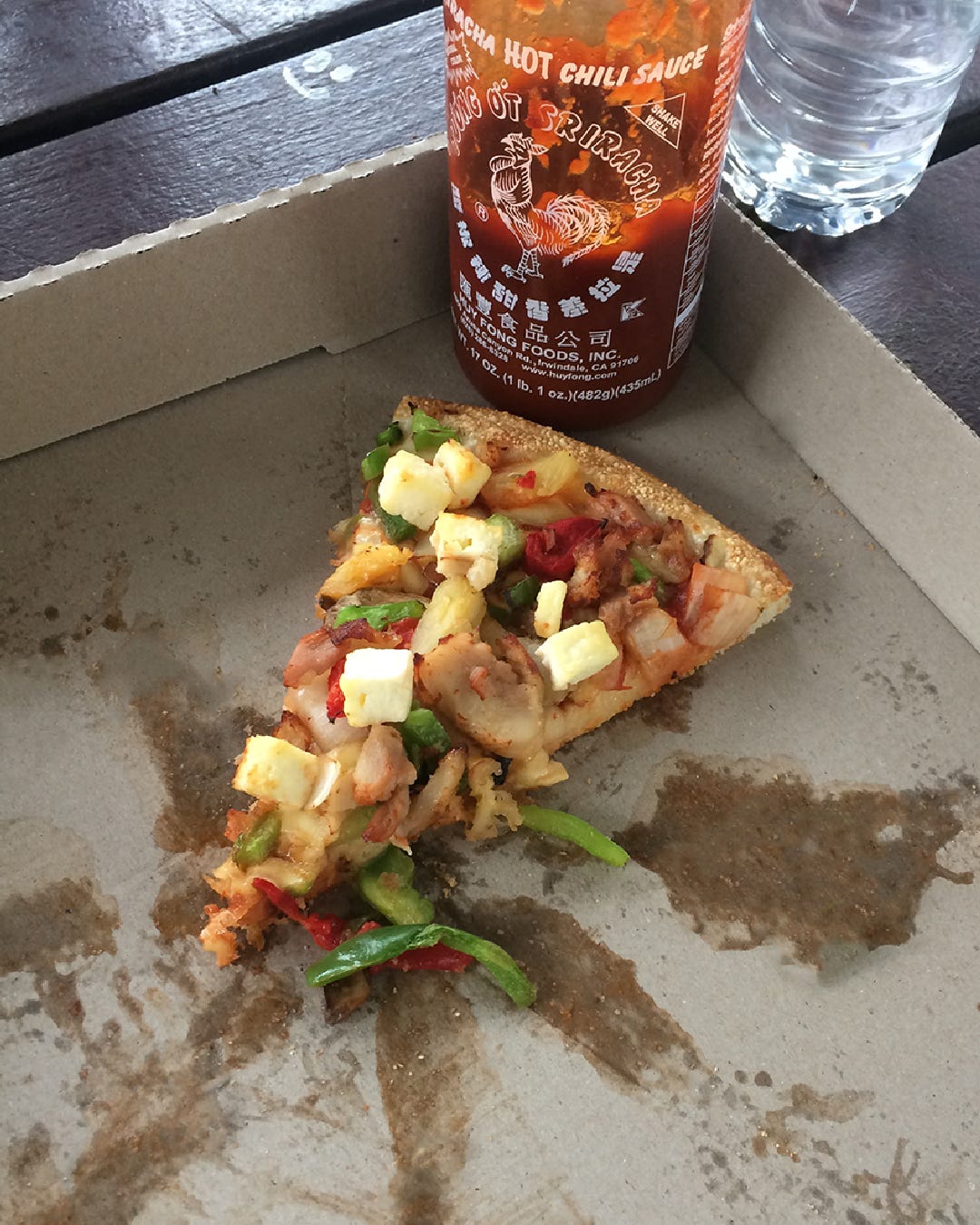Sorry, but I'm Not Sorry for Adding Saus Sambal to Everything
It's giving guilty, guilty pleasure.
Halo and happy Monday! Isn’t it crazy that we are now in the second half of 2024 already? and July is almost halfway too?! Crazy crazy. Today’s newsletter is going to be hot and spicy 🔥
But before that, if you’re new here, welcome to Kepayang! 🍄
Kepayang is a personal newsletter by me (Chalafabia Haris) where I write essays and tell stories about food, culture, and sustainability. I aim to write a new letter every two Mondays, so subscribe to get them sent directly to your inbox. Today, you will read about:
🤲 A brief intro into what saus sambal is, its origin, and the many kinds of it, including recommendations on which saus sambal pairs well with specific dishes.
💬 A few personal stories of mine around saus sambal. From bringing them abroad, finding alternatives, and being told off at a restaurant.
🌝 How I wish people embraced condiments more because they’re not harmful things and just, in fact, our silly little way to make our eating experience better.
Enjoy the read and have a spicy day!
Kepayang is free for now, so any engagements mean so much to support the platform’s growth. You can subscribe to get the newsletter sent directly to your email, like, comment, and share if you resonate with what I write.
Alternatively, you can buy me a coffee through my PayPal here: https://paypal.me/chalafabia - or if you’re based in Indonesia, you can send your donation through QRIS here (under the name Tamanan). Any amounts are welcomed and will directly contribute to sustaining this platform to cover expenses related to operations, research, writing, and marketing. ☕️
An American, a Filipino, and an Indonesian walked into a pizzeria. Each ordered their usual pizza, and they were all very happy. The glistening cheese, the fluffy dough, and the bits and pieces of warm toppings. Meat. Mushroom. Veggies. Pineapple. You name it. Everyone is enjoying their meal, at least until the second slice when they feel something is missing. The American reached for their ranch dressing - the one that came in a plastic squeeze bottle, the Filipino, quickly grabbed their bottle of banana ketchup and I, the Indonesian, pulled out my sachets of saus sambal.
The Italians are probably now busy complaining in the corner about how that’s blasphemy to a pizza, while also putting french fries on them. But we three, know that life is too short to not enjoy pizza with our favourite condiments.
Saus sambal, loosely translated into chilli sauce, is Indonesia’s most precious spicy condiment. Unlike Tabasco which is tangy and vinegary, saus sambal is usually sweet, salty, and savoury. This can clearly be seen if you just read the ingredient list: Chilli, sugar, salt, and MSG.
The idea of saus sambal is relatively new, compared to the traditional sambal that is made by hand grounding the ingredients using a cobek (mortar and pestle). Most of them use chilli as the base and the main source of heat, but it is common too to find other varieties of aromatics being added depending on who made them. For example, people from the Sumatra Utara region are known to add andaliman pepper to give a numbing sensation to their sambal, while people from the coastal region of Sulawesi Utara would add roa fish to enhance their sambal’s savouriness and add an element of smokiness. According to a study, there are more than 100 types of sambal in Indonesia, and most Indonesians would probably be able to name 10-20 types of sambal off the top of their head.
The term ‘saus’ (lit: sauce) is an umbrella term for any condiments with ingredients that are blended together, resulting in a smooth and emulsified texture.
So saus tomat, for example, would be a tomato sauce or a ketchup; and saus sambal, would be the blended version of the traditional sambal. You won’t see the chilli fleshes, chopped garlic, or white peppercorn in them, and the texture will be like, well, the common hot sauce.
While saus sambal won’t be the best sambal to eat with more traditional dishes like soto ayam (chicken soup, with a clear yellowish turmeric broth) or lalapan (raw leaves and veggies, usually cucumber or kemangi), this format of sambal opens a door of possibility to enjoy a more modern, a lot of times, westernised food with a little bit of heat.
There are more than twenty brands and types of saus sambal – each with its own signature blends of ingredients and specific uses.
In my opinion, Saus Sambal ABC is the most basic variety. It's what my parents always bought — and they’re basic. We always have them at my house. It's mildly spicy, sweet, and pairs well with fried foods like french fries, nuggets, and otak-otak (fried fish cake). But that’s about it. There’s nothing really special to them. It’s just a nice condiment to have, but it doesn’t really satisfy that craving spot. The real saus sambal aficionado (read: me) knows that there are superior saus sambals out there.
For dishes like bakso (beef meatball soup), mie ayam (chicken noodles), instant noodle soup, and other soupy dishes, I prefer Sambel Asli Cap Ibu Jari Jempol and Sambal Parkit. Both have a mild sweetness that makes them perfect for stirring into soup without overpowering the flavours. Sambal Parkit, in particular, has a thin consistency and a distinct acidity from the added vinegar. This is a plus point for clear soups because I don’t know about you, but if I’m having a clear soup, I want the broth to be light, thin, and almost watery – not thick and slurry.
But honestly, who am I kidding if I don’t say that Saus Sambal Dua Belibis is my go-to?
For me, Saus Sambal Dua Belibis is the ultimate all-rounder in the world of saus sambal. It has a subtle sweetness, a distinct garlic flavor, and just the right amount of MSG for that umami kick. Its medium consistency makes it ideal for both dipping and adding to soupy dishes (not too much though).
One of my favourite ways to enjoy Saus Sambal Dua Belibis is with fried chicken and warm white rice. Whether it’s fried ayam kuning (fried chicken, marinated in spices like turmeric, ginger, garlic, and shallots), glazed chicken wings, or since I don’t eat chicken now, it also works with those mock meats made from soy and mushrooms.
But there’s something, something special about pairing it with KFC’s fried chicken. I remember my Sydney days when I’d bring an entire bottle of Saus Sambal Dua Belibis and a lunch box filled with rice from my flat just to enjoy it with the fried chicken. You see, KFC in Australia doesn’t provide me with both of my favourite things to eat fried chicken with. So your boy needs to have them prepared.
Of course, this doesn’t happen all the time, because sometimes, I too run out of my saus sambal. So during these desperate times, I would go to my nearest Asian supermarket to get a bottle of Sriracha. While not quite the same as Saus Sambal Dua Belibis, its tangy, salty, and slightly sweet flavour hits close to home. At least close enough for me to be OK with bringing them every time I went out to get a pizza.
Adding a condiment, especially if it’s uncommon, is not meant to bait a rage or create an online controversy. It’s personal. It’s just my way of personalising the food to make them hit my tastebuds. And I wish more people and restaurants were cool with people wanting to customise their meals. As long as it is doable, what harm does it really do?
Unfortunately, a pizzeria in Jogja once told me off for asking for a saus sambal.
They are known for their artisan pizza, and you had to prebook your dough a few days before. I was so excited to eat there. The whole booking the dough thing was new to me, and the fact that they only open during certain days of the week gave me the impression of their high-quality maintenance. And it was true. The pizza was great. One of the fluffiest pizza doughs I ever tasted, great crispy crust, and fresh fresh ingredients. But it’s almost like they are focusing way too much on the freshness of the ingredients that they forget that there are people like me who also prefer, flavour and spice in their food.
“Kita nggak ada saus sambal di sini. Di sini pizzanya autentik”, the staff flat out told me. They explained that they don’t have saus sambal there because their pizzas are authentic, in the most annoyed tone as if they had heard this request for the twentieth time that night. They don’t even offer me alternatives. Which made me just disregard my other request for chilli flakes.
Wanting to add condiments is in no way a reflection of how I think your quality of food is, or a way of me saying that your food sucks. It’s not a protest or a demand to change your whole menu to taste exactly like what I want. It’s just that, I like my food a certain way. I’m just a silly boy!
Food evolves, gets modified, and transforms into new and sometimes outrageous forms every day.
A French person might freak out over croissants becoming croffles (croissant waffles), a Japanese person might eye-roll at the latest strawberry matcha trends, and an Indonesian might swear over a petai sandwich.
I agree that there should be a line between modifying food and culturally appropriating it. However, most of the time, these changes in how we consume food indicate how we are now more connected to diverse ideas while also staying true to our preferences. This, I believe, demonstrates a high level of empathy, self-awareness, and adaptability.
What do you think? When is it acceptable to bring your own condiments, and when should we read the room?
Other contents that I made recently:
📖 Read about how recipes don’t and do matter at the same time: here
☕️ Read about the different coffee culture waves and how they are today: here.
🐈 Read my first literary review, on food representation in a short story: here.
🌱 Read this essay to get deep-cut info on veganism: here.
🥤 Read this essay if you like sugary drinks: here.
🍞 Read an essay on Indonesia’s wheat dependency problem: here.
If you like today’s newsletter, please like and share it with your friends! Comment down below your thoughts and let me know if you have any other topics you want me to discuss. Until then, I’ll see you in two weeks!
Follow me everywhere:
TikTok: @berusahavegan
Kepayang’s Instagram: @readkepayang
Instagram: @menggemaskan
LinkedIn: Chalafabia Haris
Work with me: readkepayang@gmail.com





